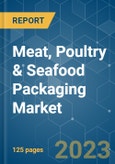The meat, poultry & seafood packaging market is projected to register a CAGR of 4.30% over the forecast period. The growing population is expected to increase the demand for food items, which may, in turn, act as a driver for the meat, poultry & seafood packaging industry during the forecast period.
This product will be delivered within 2 business days.
Key Highlights
- The increased need for disposable packaging in the offices and retail sector and the rising investment in the packaging industry by manufacturers and retailers are boosting the meat, poultry & seafood packaging industry.
- Consumer interaction with meat, poultry, and seafood packaging is changing with an increasing focus on sustainability and rigid and flexible packaging solutions, which are being improved daily with new innovative packaging solutions.
- The increasing demand for consumer-friendly packages and enhanced product protection have propelled meat, poultry, and seafood packaging as a viable and cost-effective alternative.
- The rising GDP and population may accelerate market expansion. In addition, the consumer-friendly storage and resealability conditions are contributing to the market's development worldwide.
- However, the risk of contamination of the packaging material may hinder the market's growth. Sometimes, toxic flame retardants, which are made from styrene and benzene, contaminate the food material due to poor packaging or mishandling.
- The threat of bird flu during COVID-19 reduced meat and poultry consumption worldwide. Thus, the market for packaging meat, poultry, and seafood was negatively impacted during the pandemic. Many individuals were forced to reconsider eating meat and going to restaurants due to the threat of virus and bird flu.
Meat, Poultry & Seafood Packaging Market Trends
Flexible Packaging to Witness Growth
- Due to factors like the rising consumption of animal products, the market for flexible packaging solutions is predicted to have exponential growth throughout the forecast period.
- Factors such as the increasing world population, rising incomes, and urbanization are strongly and positively related to the consumption of animal products. The World Health Organization (WHO) estimates that meat consumption may increase to 376 million metric tons by 2030, from 218 million metric tons during 1997-1999.
- The growing availability of beef and pork products in large and reliable retail chains across international borders is also strengthening the market. The need for thermoformed high-barrier films and retort packaging is increasing as consumers seek products with longer shelf-lives.
- Ready-made meals have grown in popularity among consumers as they prefer products that include fish, meat, and vegetables and are typically retort-packed to make them shelf-stable. The rising trend of internet shopping has further boosted their confidence.
- While stand-up pouches will continue to displace bags in frozen applications due to their attractive looks, ability to stand upright, and wide front panels, all of which provide merchandising advantages, vacuum pouches in single-part fresh, frozen, and processed usage have potential for growth.
- However, the use of flexible packaging increased due to their several benefits, such as live on-site butchering, improved sanitation, tracking, and recall, as well as prolonged shelf life.
Asia-Pacific Holds the Largest Market Share
- The Asia-Pacific region holds the largest market share, primarily due to the emerging population of India and China. Due to the growing applications of rigid packaging and flexible packaging in the meat, poultry, and seafood packaging industries, the market is expected to grow.
- The region's rising per capita income, rising health consciousness, and shifting lifestyle trends are the main factors behind the expansion of the meat, poultry, and seafood packaging industry. The area boasts an abundance of raw materials for producing thermoforming, plastic, and aluminium packaging.
- Country-wise (China and India), emerging economies to promote import and export have been significant contributors to the global market. Increasing demand for disposable packaging has led to an upward trend in the market. The market in Asia-Pacific is expected to boost during the forecast period.
- The growing competition and packaging standards set by the government for labeling quality, quantity, and price, coupled with the demand for easy and convenient packaging, have been instrumental in driving the adoption of meat, poultry, and seafood packaging.
Meat, Poultry & Seafood Packaging Market Competitor Analysis
The market is fragmented due to existing players, including Berry Global, Mondi Group, Amcor, Crown Holdings, DS Smith, and Sonoco. Several local and international vendors in the area have already made significant R&D investments to enhance the food packaging materials. As a result, they frequently develop novel solutions at a lower cost, creating fierce competition among market participants.- August 2022 - Amcor announced the acquisition of a flexible packaging plant in the Czech Republic, which may increase and expand Amcor’s portfolio of ability to meet strong demand and customer growth across its flexible packaging network in Europe.
Additional benefits of purchasing the report:
- The market estimate (ME) sheet in Excel format
- 3 months of analyst support
This product will be delivered within 2 business days.
Table of Contents
1 INTRODUCTION
4 MARKET INSIGHTS
5 MARKET DYNAMICS
6 MARKET SEGMENTATION
7 COMPETITIVE LANDSCAPE
Companies Mentioned (Partial List)
A selection of companies mentioned in this report includes, but is not limited to:
- Berry Global
- Mondi Group
- Sealed Air
- Amcor
- Sonoco
- Smurfit Kappa Group
- DS Smith
- WestRock
- Stora Enso
- Crown Holdings
- Can-Pack SA
Methodology

LOADING...










